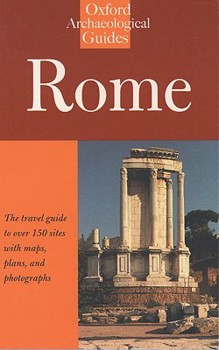Rome: An Oxford Archaeological Guide
Select Format
Select Condition 
Book Overview
This text consists of an illustrated guide to all the major sites in twelve main areas in central Rome, and four in Greater Rome, including the Capitoline Hill, Roman Forum, Colosseum, Mausoleums of Augustus and Hadrian, the Circus Maximus, Catacombs, Ostia, and Tivoli.
Format:Paperback
Language:English
ISBN:0192880039
ISBN13:9780192880031
Release Date:June 1998
Publisher:Oxford University Press, USA
Length:464 Pages
Weight:1.34 lbs.
Dimensions:1.1" x 5.4" x 8.5"
Customer Reviews
5 ratings
Excellent Guide to Ancient Rome
Published by Thriftbooks.com User , 18 years ago
I just returned from Rome, using this book as my primary guide. We were able to identify almost every random bit of ancient archaelogy sticking out of the ground as we walked about the city, and if you've been to Rome, you'll understand how impressive that is. A major shortcoming that I noticed is that the book treats the ancient-era churches very lightly: while the myths of gods such as Pollux and Castor are frequently referenced in relation to the ancient sites, the C1 AD story of Saint Clement is inexplicably left out of the section on the church of San Clemente constructed by Constantine. Also, as the author states in the beginning, the intent of this guide is to detail ancient Rome only. If you are interested in medieval, Renaissance, or ecclessiastic history, you will certainly need a supplemental guide. Now, for the advantages... The guide systematically presents every ancient structure in Rome (we were never disappointed), providing a very good map at the beginning of each chapter for a major area (e.g. the Palatine, Field of Mars) to help you identify what you are looking at. The site is laid out in a sort of walking tour format and if you begin at the point suggested, you can follow the chapter page by page as it logically guides you through the region. We did find that writing in page references for each location on the map at the beginning made the book much easier to use. For more complicated buildings, additional diagrams are provided in the appropriate subsection where it is further detailed. The Baths of Caracalla are a superb example of this. While Claridge delves a bit too thoroughly into the exact type of marble used in the facing and floors of each building, you find yourself recognizing the materials and envisioning the baths, basillicas, and forums as they might have looked clad in Phyrgian red and Numidian yellow marbles. With frequent referencing, we soon became familiar with Caracella, Domitian, and Nerva as we viewed the great construction projects they enacted. The author presents quite clearly the historical origin and significance of each site as well as its original appearance (if known) and the many refurbishments it went through with the frequent fires of Rome. For our trip, we opted out of taking any tours, and we didn't feel we missed anything. We were often surrounded by tours and gained more information from our book than the guide was sharing with his group. You never know how reliable a guide really is, and with this book, you can be assured of Amanda Claridge's credentials. The trip became a bit of a mystery adventure for us as we excitedly reconstructed the ruins around us into the elegant structures they once were. Even if you do decide to go with a more mainstream guide book for your trip to Rome, you will find this one to be an invaluable supplement for all those tidbits that the major guides just don't have time to cover.
Great Archaeological History of Rome
Published by Thriftbooks.com User , 20 years ago
Claridge's Oxford Guide to Rome is probably the best out there today among the many, many ancient guides to Rome. The guide is steeped in research and archaeological evidence which is perfect for the first time visitor to Rome. The maps and plans that she includes are extremely helpful to the visitor since some of the sites are merely a pile of rocks and might be difficult to visualize in their ancient glory. The plans and cross-sections of buildings and areas of Rome are essential to understanding the ancient city when it was complete. This guide also comes in handy when visiting the Roman Forum and the Imperial Fora as the buildings are not extremely well marked nor do they have much information to provide for the visitor. If you ever go to the Forum you MUST have Claridge with you because it is the only way you can begin to comprehend the complexity of the Forum. Claridge's details and historical facts that she adds to each building are essential. As difficult as it is for the untrained visitor to try and extricate the buildings and monuments that were built at the same time or before and after one another, Claridge does a good job in trying to convey the urban growth of Rome. She does this but her clear descriptions and helpful plans. Essential to any visitor to Rome, especially any history or archaeological buff.
Unique guide for the archaeology minded traveler to Rome
Published by Thriftbooks.com User , 22 years ago
The little known Oxford Archaeological Guides series provides information that you cannot find elsewhere. This guide was written by Amanda Claridge in 1998 and gives information about many of the archaeological sites of Rome. Sites are described in great detail with an emphasis on how the site might have looked in ancient times and changes occurring over centuries. Famous artifacts that were once part of these sites are described and their present locations are mentioned. You learn where in the baths of Caracalla the famous Farnese Hercules and Farnese Bull were located and you learn how they came to be in the archaeological museum at Naples. There are little known sites like the tomb of the Scipios as well as places as familiar as the Piazza Navona and the Colloseum. Obscure but fascinating information is given: the great brick reinforcing wedge on the southeast side of the Colloseum was built in 1807: I have not seen this information anywhere else. The oval Piazza Navona is built on the site of the Stadium of Domitian of 86 AD; the stores that line its periphery are built on top of the ancient seating. This book would not be suitable as the only guidebook to take with you on a trip, the information provided is far too specialized. I'd recommend taking along the Michelin Green guide or the Knopf guide for Rome as well. Some minor drawbacks: the drawings and maps are not as detailed as they could be and the few photographs that are provided are black and white and of poor quality. These complaints are not critical flaws; the book would still be invaluable even if it didn't contain a single illustration.
If your focus is ancient Rome, this is indispensable
Published by Thriftbooks.com User , 23 years ago
I saw this book randomly in a bookstore before I had ever been to Rome, and decided to buy it. The diagrams and maps inside were interesting even to scan, and the description of the sites and their history gave me a better sense of what I wanted to see on my trip. When in Rome, I carried this book everywhere. In addition to the standard highlights -- detailed descriptions of each item on the Forum, the Upper Via Sacra, the Palatine, etc. -- this book had coverage of the archeological sites that seem to be on random street corners throughout Rome. If I came across something that looked interesting, I could look it up on the maps, then find the text. Often, there would be a helpful diagram of the original site layout that allowed me to make sense of what stones were standing (and often there aren't many). The book also lists gems of archeological sites that I never would have planned to see had I not read parts of it before my trip. That said, this book has more detail than the casual tourist needs or wants. Much more. But if you want to spend several days delving around ancient Rome, then this book deserves your attention.
Don't leave for Rome without it.
Published by Thriftbooks.com User , 26 years ago
This is the best guidebook in English on Rome's antiquities. It pulls together lots of information (eg., types of building stone, construction techniques) hidden in specialized sources. The descriptions and plans of the monuments make them rise in your mind to their former glory. I've been to Rome several times, and this author really knows her stuff. Now if only there were guidebooks this good on medieval, Renaissance, etc. Rome!
Rome: An Oxford Archaeological Guide (Oxford Archaeological Guides) Mentions in Our Blog

National Bikini Day: How Four Little Triangles of Fabric Changed the World
Published by Beth Clark • July 05, 2018
On July 5, 1946, the bikini debuted and forever altered swimwear so dramatically that the ripples are still being felt 72 years later!





